Comprehensive Report on Australian Commercial Law and Legal Framework
VerifiedAdded on 2019/11/12
|14
|2762
|103
Report
AI Summary
This report provides a comprehensive analysis of Australian Commercial Law, beginning with an introduction to the legal system and an application of Hart's analysis to the rules of the constitution. It then explores the features of the Australian legal system, focusing on how businesses and individuals operate within its framework, including the distinction between primary and secondary rules and the common law tradition. The report delves into a case study of Barton v Armstrong (1976) to illustrate the concept of genuine consent in contract law and examines issues of duress. Finally, it addresses a scenario involving a breach of contract due to natural calamities, discussing legal obligations and potential outcomes based on contract law principles and relevant case law like Vincent v Lake Erie Transportation Co (1910). The report provides insights into various aspects of commercial law in Australia.
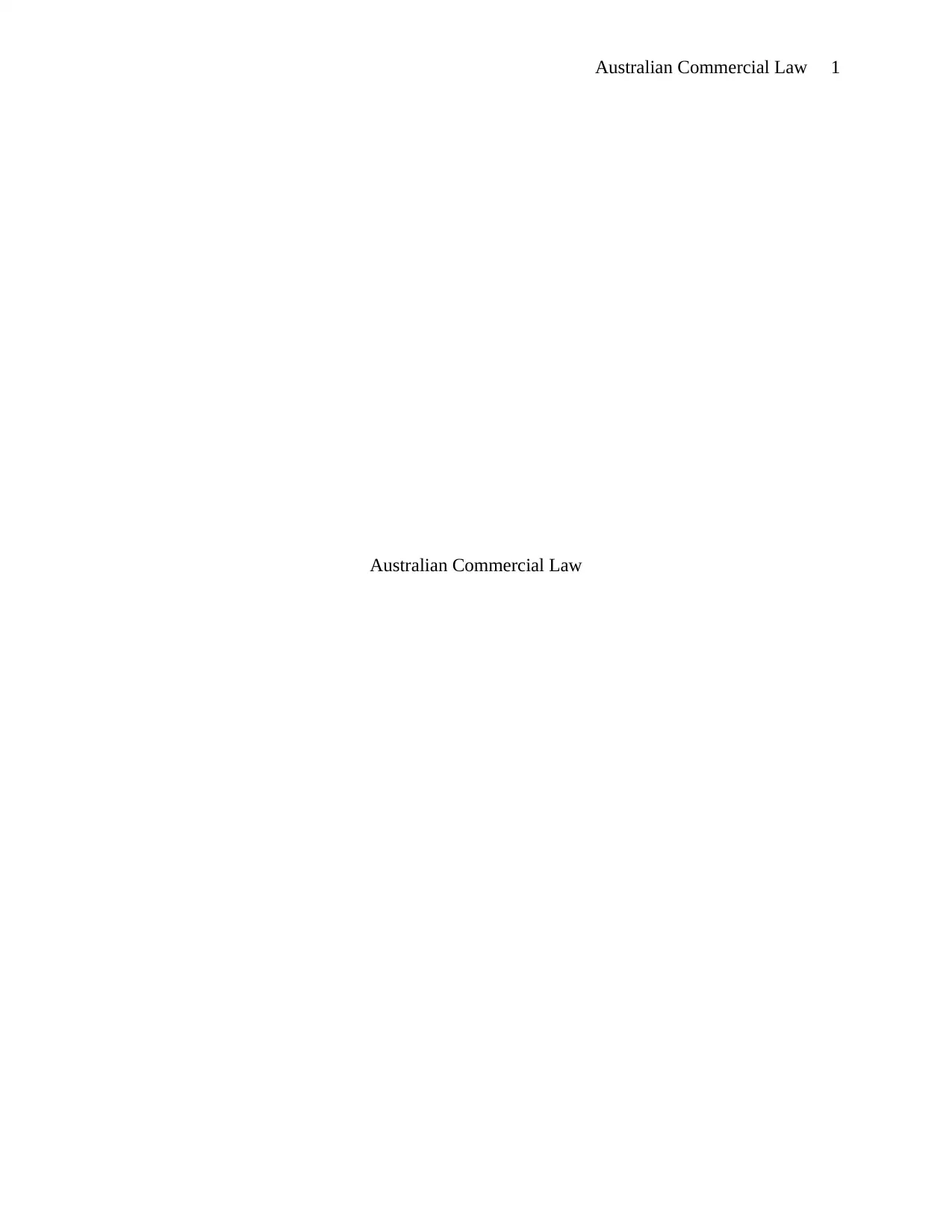
Australian Commercial Law 1
Australian Commercial Law
Australian Commercial Law
Paraphrase This Document
Need a fresh take? Get an instant paraphrase of this document with our AI Paraphraser
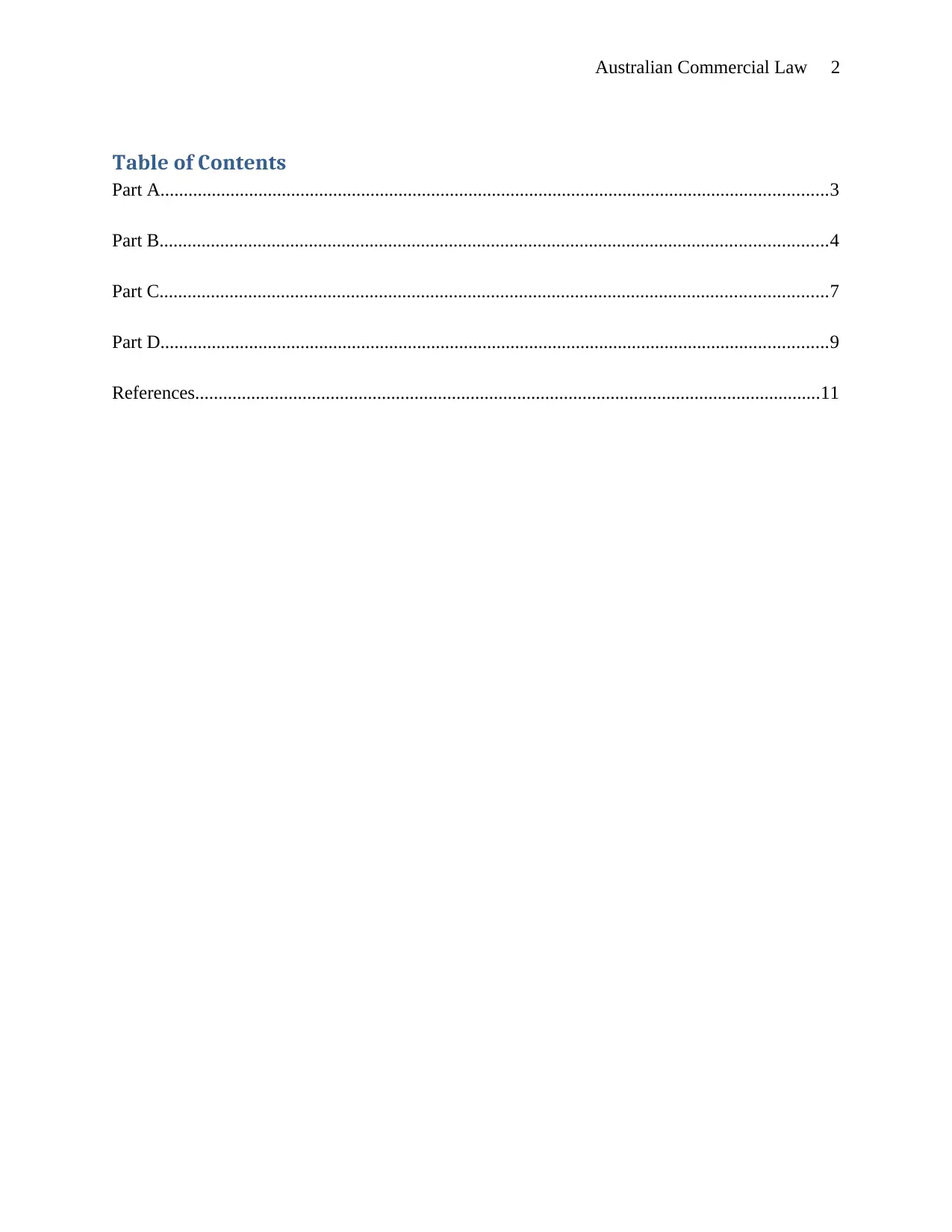
Australian Commercial Law 2
Table of Contents
Part A...............................................................................................................................................3
Part B...............................................................................................................................................4
Part C...............................................................................................................................................7
Part D...............................................................................................................................................9
References......................................................................................................................................11
Table of Contents
Part A...............................................................................................................................................3
Part B...............................................................................................................................................4
Part C...............................................................................................................................................7
Part D...............................................................................................................................................9
References......................................................................................................................................11
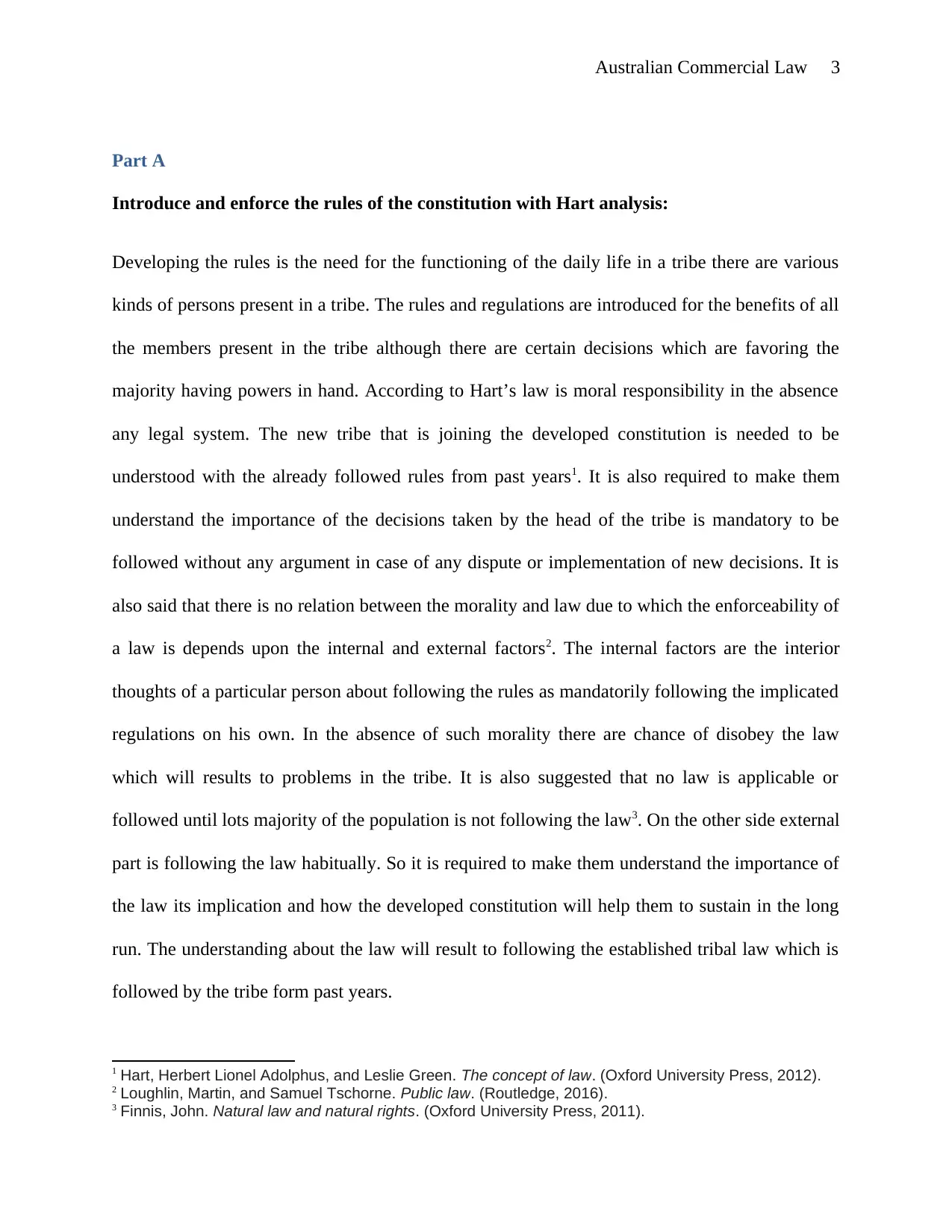
Australian Commercial Law 3
Part A
Introduce and enforce the rules of the constitution with Hart analysis:
Developing the rules is the need for the functioning of the daily life in a tribe there are various
kinds of persons present in a tribe. The rules and regulations are introduced for the benefits of all
the members present in the tribe although there are certain decisions which are favoring the
majority having powers in hand. According to Hart’s law is moral responsibility in the absence
any legal system. The new tribe that is joining the developed constitution is needed to be
understood with the already followed rules from past years1. It is also required to make them
understand the importance of the decisions taken by the head of the tribe is mandatory to be
followed without any argument in case of any dispute or implementation of new decisions. It is
also said that there is no relation between the morality and law due to which the enforceability of
a law is depends upon the internal and external factors2. The internal factors are the interior
thoughts of a particular person about following the rules as mandatorily following the implicated
regulations on his own. In the absence of such morality there are chance of disobey the law
which will results to problems in the tribe. It is also suggested that no law is applicable or
followed until lots majority of the population is not following the law3. On the other side external
part is following the law habitually. So it is required to make them understand the importance of
the law its implication and how the developed constitution will help them to sustain in the long
run. The understanding about the law will result to following the established tribal law which is
followed by the tribe form past years.
1 Hart, Herbert Lionel Adolphus, and Leslie Green. The concept of law. (Oxford University Press, 2012).
2 Loughlin, Martin, and Samuel Tschorne. Public law. (Routledge, 2016).
3 Finnis, John. Natural law and natural rights. (Oxford University Press, 2011).
Part A
Introduce and enforce the rules of the constitution with Hart analysis:
Developing the rules is the need for the functioning of the daily life in a tribe there are various
kinds of persons present in a tribe. The rules and regulations are introduced for the benefits of all
the members present in the tribe although there are certain decisions which are favoring the
majority having powers in hand. According to Hart’s law is moral responsibility in the absence
any legal system. The new tribe that is joining the developed constitution is needed to be
understood with the already followed rules from past years1. It is also required to make them
understand the importance of the decisions taken by the head of the tribe is mandatory to be
followed without any argument in case of any dispute or implementation of new decisions. It is
also said that there is no relation between the morality and law due to which the enforceability of
a law is depends upon the internal and external factors2. The internal factors are the interior
thoughts of a particular person about following the rules as mandatorily following the implicated
regulations on his own. In the absence of such morality there are chance of disobey the law
which will results to problems in the tribe. It is also suggested that no law is applicable or
followed until lots majority of the population is not following the law3. On the other side external
part is following the law habitually. So it is required to make them understand the importance of
the law its implication and how the developed constitution will help them to sustain in the long
run. The understanding about the law will result to following the established tribal law which is
followed by the tribe form past years.
1 Hart, Herbert Lionel Adolphus, and Leslie Green. The concept of law. (Oxford University Press, 2012).
2 Loughlin, Martin, and Samuel Tschorne. Public law. (Routledge, 2016).
3 Finnis, John. Natural law and natural rights. (Oxford University Press, 2011).
⊘ This is a preview!⊘
Do you want full access?
Subscribe today to unlock all pages.

Trusted by 1+ million students worldwide

Australian Commercial Law 4
Paraphrase This Document
Need a fresh take? Get an instant paraphrase of this document with our AI Paraphraser
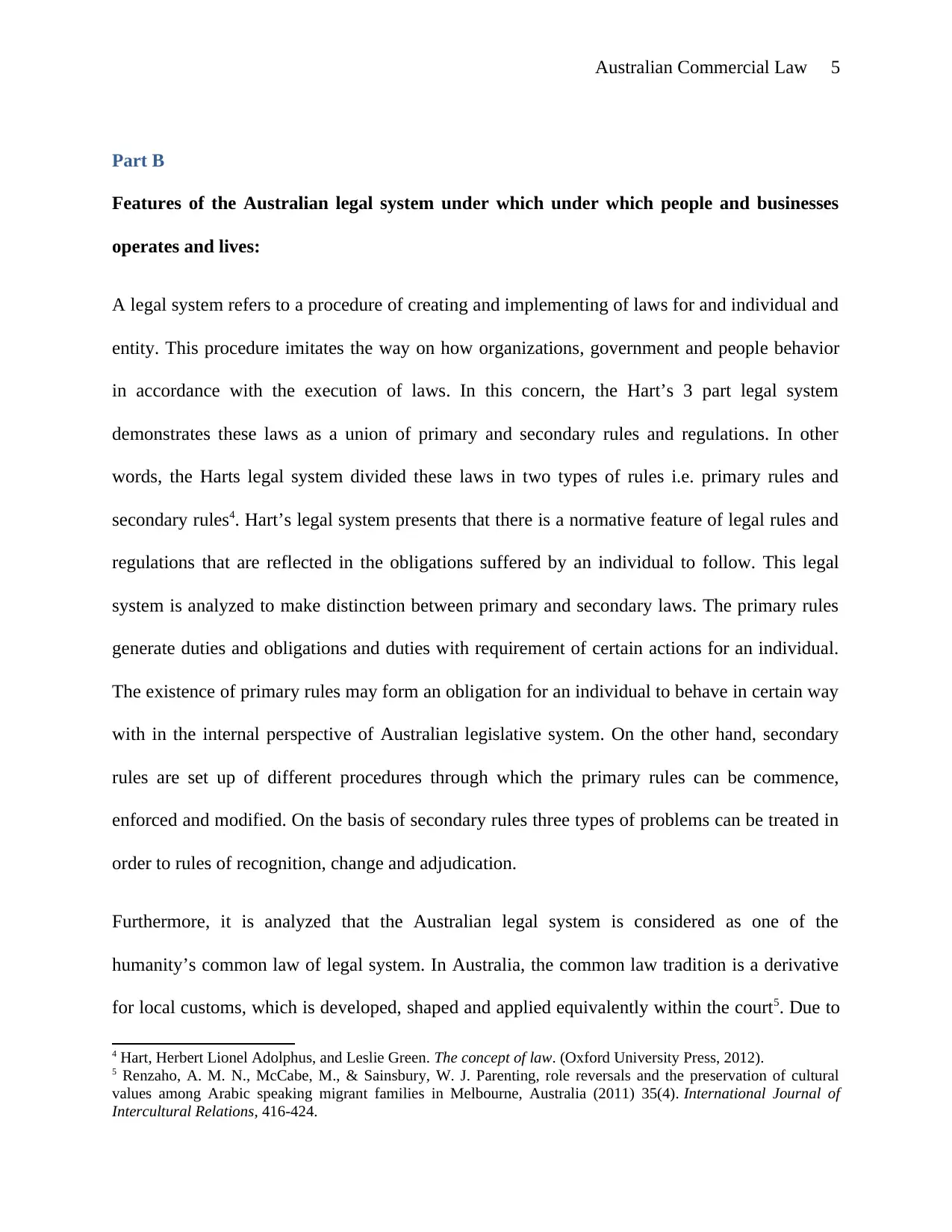
Australian Commercial Law 5
Part B
Features of the Australian legal system under which under which people and businesses
operates and lives:
A legal system refers to a procedure of creating and implementing of laws for and individual and
entity. This procedure imitates the way on how organizations, government and people behavior
in accordance with the execution of laws. In this concern, the Hart’s 3 part legal system
demonstrates these laws as a union of primary and secondary rules and regulations. In other
words, the Harts legal system divided these laws in two types of rules i.e. primary rules and
secondary rules4. Hart’s legal system presents that there is a normative feature of legal rules and
regulations that are reflected in the obligations suffered by an individual to follow. This legal
system is analyzed to make distinction between primary and secondary laws. The primary rules
generate duties and obligations and duties with requirement of certain actions for an individual.
The existence of primary rules may form an obligation for an individual to behave in certain way
with in the internal perspective of Australian legislative system. On the other hand, secondary
rules are set up of different procedures through which the primary rules can be commence,
enforced and modified. On the basis of secondary rules three types of problems can be treated in
order to rules of recognition, change and adjudication.
Furthermore, it is analyzed that the Australian legal system is considered as one of the
humanity’s common law of legal system. In Australia, the common law tradition is a derivative
for local customs, which is developed, shaped and applied equivalently within the court5. Due to
4 Hart, Herbert Lionel Adolphus, and Leslie Green. The concept of law. (Oxford University Press, 2012).
5 Renzaho, A. M. N., McCabe, M., & Sainsbury, W. J. Parenting, role reversals and the preservation of cultural
values among Arabic speaking migrant families in Melbourne, Australia (2011) 35(4). International Journal of
Intercultural Relations, 416-424.
Part B
Features of the Australian legal system under which under which people and businesses
operates and lives:
A legal system refers to a procedure of creating and implementing of laws for and individual and
entity. This procedure imitates the way on how organizations, government and people behavior
in accordance with the execution of laws. In this concern, the Hart’s 3 part legal system
demonstrates these laws as a union of primary and secondary rules and regulations. In other
words, the Harts legal system divided these laws in two types of rules i.e. primary rules and
secondary rules4. Hart’s legal system presents that there is a normative feature of legal rules and
regulations that are reflected in the obligations suffered by an individual to follow. This legal
system is analyzed to make distinction between primary and secondary laws. The primary rules
generate duties and obligations and duties with requirement of certain actions for an individual.
The existence of primary rules may form an obligation for an individual to behave in certain way
with in the internal perspective of Australian legislative system. On the other hand, secondary
rules are set up of different procedures through which the primary rules can be commence,
enforced and modified. On the basis of secondary rules three types of problems can be treated in
order to rules of recognition, change and adjudication.
Furthermore, it is analyzed that the Australian legal system is considered as one of the
humanity’s common law of legal system. In Australia, the common law tradition is a derivative
for local customs, which is developed, shaped and applied equivalently within the court5. Due to
4 Hart, Herbert Lionel Adolphus, and Leslie Green. The concept of law. (Oxford University Press, 2012).
5 Renzaho, A. M. N., McCabe, M., & Sainsbury, W. J. Parenting, role reversals and the preservation of cultural
values among Arabic speaking migrant families in Melbourne, Australia (2011) 35(4). International Journal of
Intercultural Relations, 416-424.
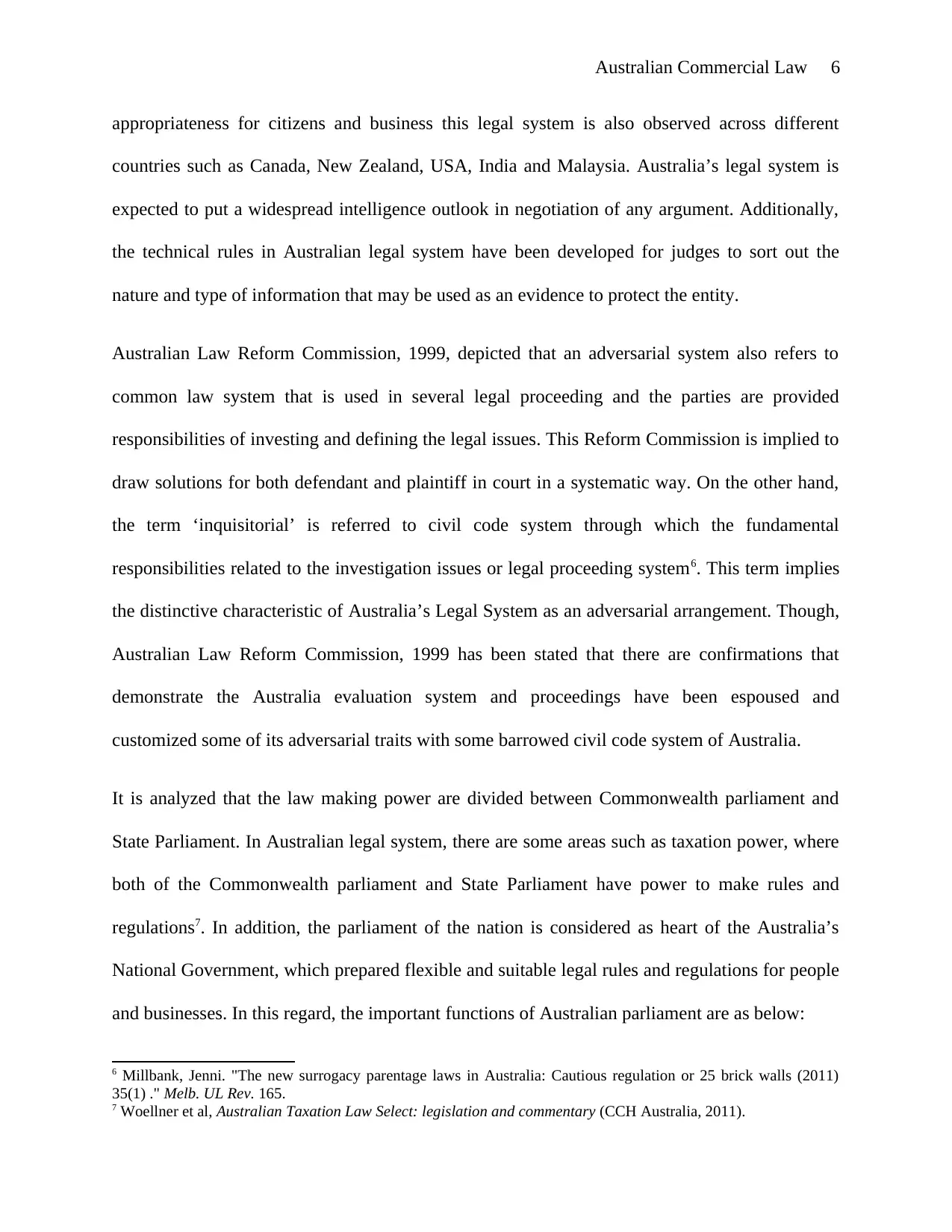
Australian Commercial Law 6
appropriateness for citizens and business this legal system is also observed across different
countries such as Canada, New Zealand, USA, India and Malaysia. Australia’s legal system is
expected to put a widespread intelligence outlook in negotiation of any argument. Additionally,
the technical rules in Australian legal system have been developed for judges to sort out the
nature and type of information that may be used as an evidence to protect the entity.
Australian Law Reform Commission, 1999, depicted that an adversarial system also refers to
common law system that is used in several legal proceeding and the parties are provided
responsibilities of investing and defining the legal issues. This Reform Commission is implied to
draw solutions for both defendant and plaintiff in court in a systematic way. On the other hand,
the term ‘inquisitorial’ is referred to civil code system through which the fundamental
responsibilities related to the investigation issues or legal proceeding system6. This term implies
the distinctive characteristic of Australia’s Legal System as an adversarial arrangement. Though,
Australian Law Reform Commission, 1999 has been stated that there are confirmations that
demonstrate the Australia evaluation system and proceedings have been espoused and
customized some of its adversarial traits with some barrowed civil code system of Australia.
It is analyzed that the law making power are divided between Commonwealth parliament and
State Parliament. In Australian legal system, there are some areas such as taxation power, where
both of the Commonwealth parliament and State Parliament have power to make rules and
regulations7. In addition, the parliament of the nation is considered as heart of the Australia’s
National Government, which prepared flexible and suitable legal rules and regulations for people
and businesses. In this regard, the important functions of Australian parliament are as below:
6 Millbank, Jenni. "The new surrogacy parentage laws in Australia: Cautious regulation or 25 brick walls (2011)
35(1) ." Melb. UL Rev. 165.
7 Woellner et al, Australian Taxation Law Select: legislation and commentary (CCH Australia, 2011).
appropriateness for citizens and business this legal system is also observed across different
countries such as Canada, New Zealand, USA, India and Malaysia. Australia’s legal system is
expected to put a widespread intelligence outlook in negotiation of any argument. Additionally,
the technical rules in Australian legal system have been developed for judges to sort out the
nature and type of information that may be used as an evidence to protect the entity.
Australian Law Reform Commission, 1999, depicted that an adversarial system also refers to
common law system that is used in several legal proceeding and the parties are provided
responsibilities of investing and defining the legal issues. This Reform Commission is implied to
draw solutions for both defendant and plaintiff in court in a systematic way. On the other hand,
the term ‘inquisitorial’ is referred to civil code system through which the fundamental
responsibilities related to the investigation issues or legal proceeding system6. This term implies
the distinctive characteristic of Australia’s Legal System as an adversarial arrangement. Though,
Australian Law Reform Commission, 1999 has been stated that there are confirmations that
demonstrate the Australia evaluation system and proceedings have been espoused and
customized some of its adversarial traits with some barrowed civil code system of Australia.
It is analyzed that the law making power are divided between Commonwealth parliament and
State Parliament. In Australian legal system, there are some areas such as taxation power, where
both of the Commonwealth parliament and State Parliament have power to make rules and
regulations7. In addition, the parliament of the nation is considered as heart of the Australia’s
National Government, which prepared flexible and suitable legal rules and regulations for people
and businesses. In this regard, the important functions of Australian parliament are as below:
6 Millbank, Jenni. "The new surrogacy parentage laws in Australia: Cautious regulation or 25 brick walls (2011)
35(1) ." Melb. UL Rev. 165.
7 Woellner et al, Australian Taxation Law Select: legislation and commentary (CCH Australia, 2011).
⊘ This is a preview!⊘
Do you want full access?
Subscribe today to unlock all pages.

Trusted by 1+ million students worldwide
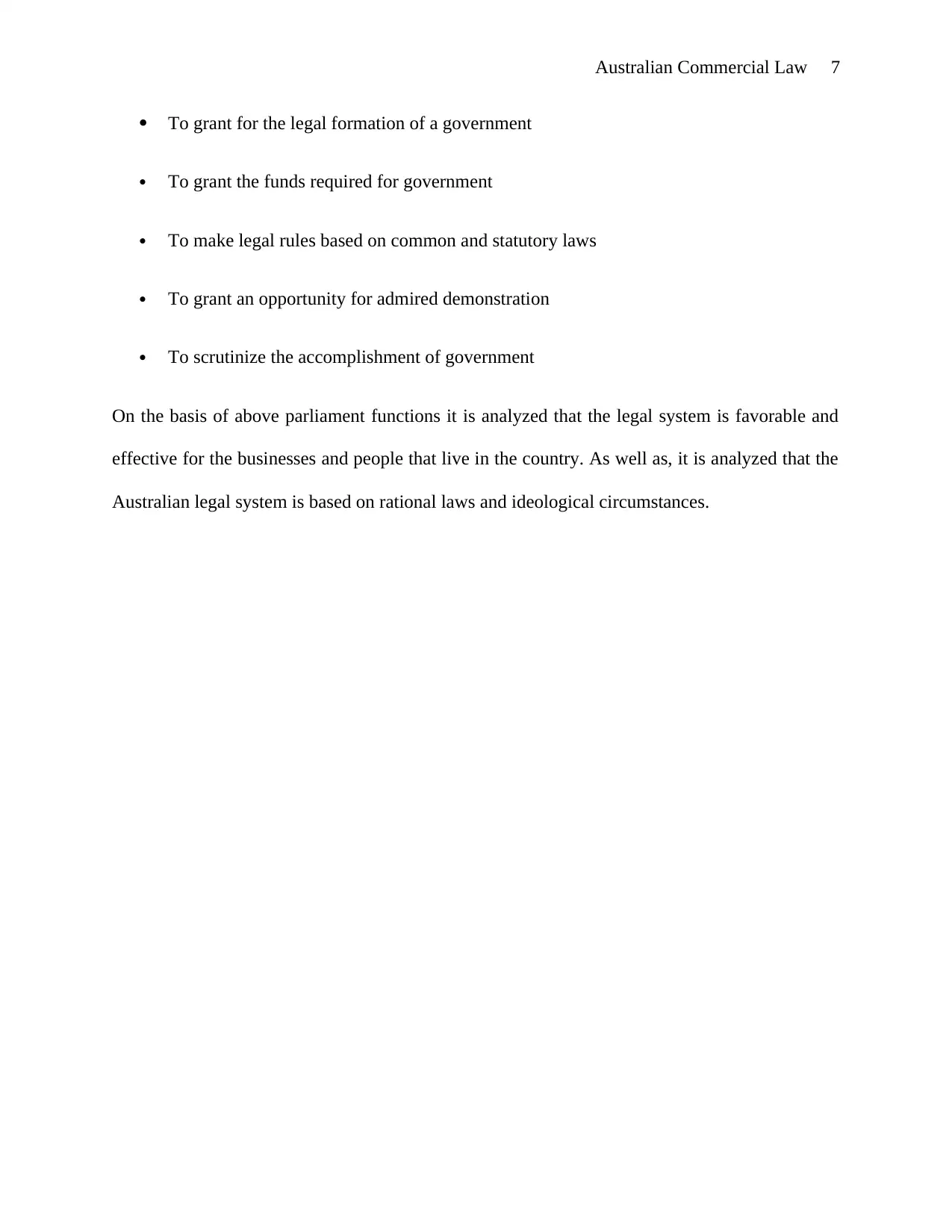
Australian Commercial Law 7
To grant for the legal formation of a government
To grant the funds required for government
To make legal rules based on common and statutory laws
To grant an opportunity for admired demonstration
To scrutinize the accomplishment of government
On the basis of above parliament functions it is analyzed that the legal system is favorable and
effective for the businesses and people that live in the country. As well as, it is analyzed that the
Australian legal system is based on rational laws and ideological circumstances.
To grant for the legal formation of a government
To grant the funds required for government
To make legal rules based on common and statutory laws
To grant an opportunity for admired demonstration
To scrutinize the accomplishment of government
On the basis of above parliament functions it is analyzed that the legal system is favorable and
effective for the businesses and people that live in the country. As well as, it is analyzed that the
Australian legal system is based on rational laws and ideological circumstances.
Paraphrase This Document
Need a fresh take? Get an instant paraphrase of this document with our AI Paraphraser
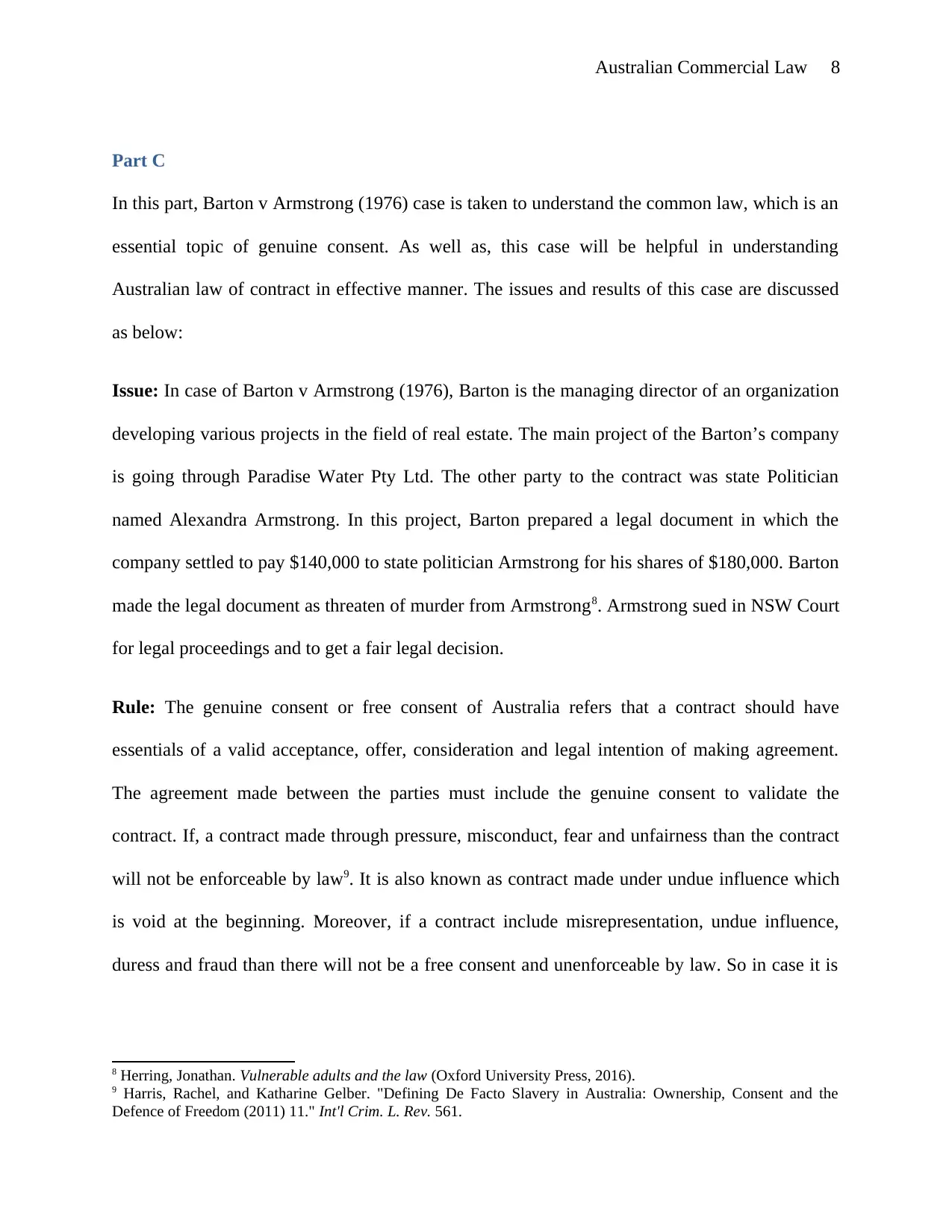
Australian Commercial Law 8
Part C
In this part, Barton v Armstrong (1976) case is taken to understand the common law, which is an
essential topic of genuine consent. As well as, this case will be helpful in understanding
Australian law of contract in effective manner. The issues and results of this case are discussed
as below:
Issue: In case of Barton v Armstrong (1976), Barton is the managing director of an organization
developing various projects in the field of real estate. The main project of the Barton’s company
is going through Paradise Water Pty Ltd. The other party to the contract was state Politician
named Alexandra Armstrong. In this project, Barton prepared a legal document in which the
company settled to pay $140,000 to state politician Armstrong for his shares of $180,000. Barton
made the legal document as threaten of murder from Armstrong8. Armstrong sued in NSW Court
for legal proceedings and to get a fair legal decision.
Rule: The genuine consent or free consent of Australia refers that a contract should have
essentials of a valid acceptance, offer, consideration and legal intention of making agreement.
The agreement made between the parties must include the genuine consent to validate the
contract. If, a contract made through pressure, misconduct, fear and unfairness than the contract
will not be enforceable by law9. It is also known as contract made under undue influence which
is void at the beginning. Moreover, if a contract include misrepresentation, undue influence,
duress and fraud than there will not be a free consent and unenforceable by law. So in case it is
8 Herring, Jonathan. Vulnerable adults and the law (Oxford University Press, 2016).
9 Harris, Rachel, and Katharine Gelber. "Defining De Facto Slavery in Australia: Ownership, Consent and the
Defence of Freedom (2011) 11." Int'l Crim. L. Rev. 561.
Part C
In this part, Barton v Armstrong (1976) case is taken to understand the common law, which is an
essential topic of genuine consent. As well as, this case will be helpful in understanding
Australian law of contract in effective manner. The issues and results of this case are discussed
as below:
Issue: In case of Barton v Armstrong (1976), Barton is the managing director of an organization
developing various projects in the field of real estate. The main project of the Barton’s company
is going through Paradise Water Pty Ltd. The other party to the contract was state Politician
named Alexandra Armstrong. In this project, Barton prepared a legal document in which the
company settled to pay $140,000 to state politician Armstrong for his shares of $180,000. Barton
made the legal document as threaten of murder from Armstrong8. Armstrong sued in NSW Court
for legal proceedings and to get a fair legal decision.
Rule: The genuine consent or free consent of Australia refers that a contract should have
essentials of a valid acceptance, offer, consideration and legal intention of making agreement.
The agreement made between the parties must include the genuine consent to validate the
contract. If, a contract made through pressure, misconduct, fear and unfairness than the contract
will not be enforceable by law9. It is also known as contract made under undue influence which
is void at the beginning. Moreover, if a contract include misrepresentation, undue influence,
duress and fraud than there will not be a free consent and unenforceable by law. So in case it is
8 Herring, Jonathan. Vulnerable adults and the law (Oxford University Press, 2016).
9 Harris, Rachel, and Katharine Gelber. "Defining De Facto Slavery in Australia: Ownership, Consent and the
Defence of Freedom (2011) 11." Int'l Crim. L. Rev. 561.
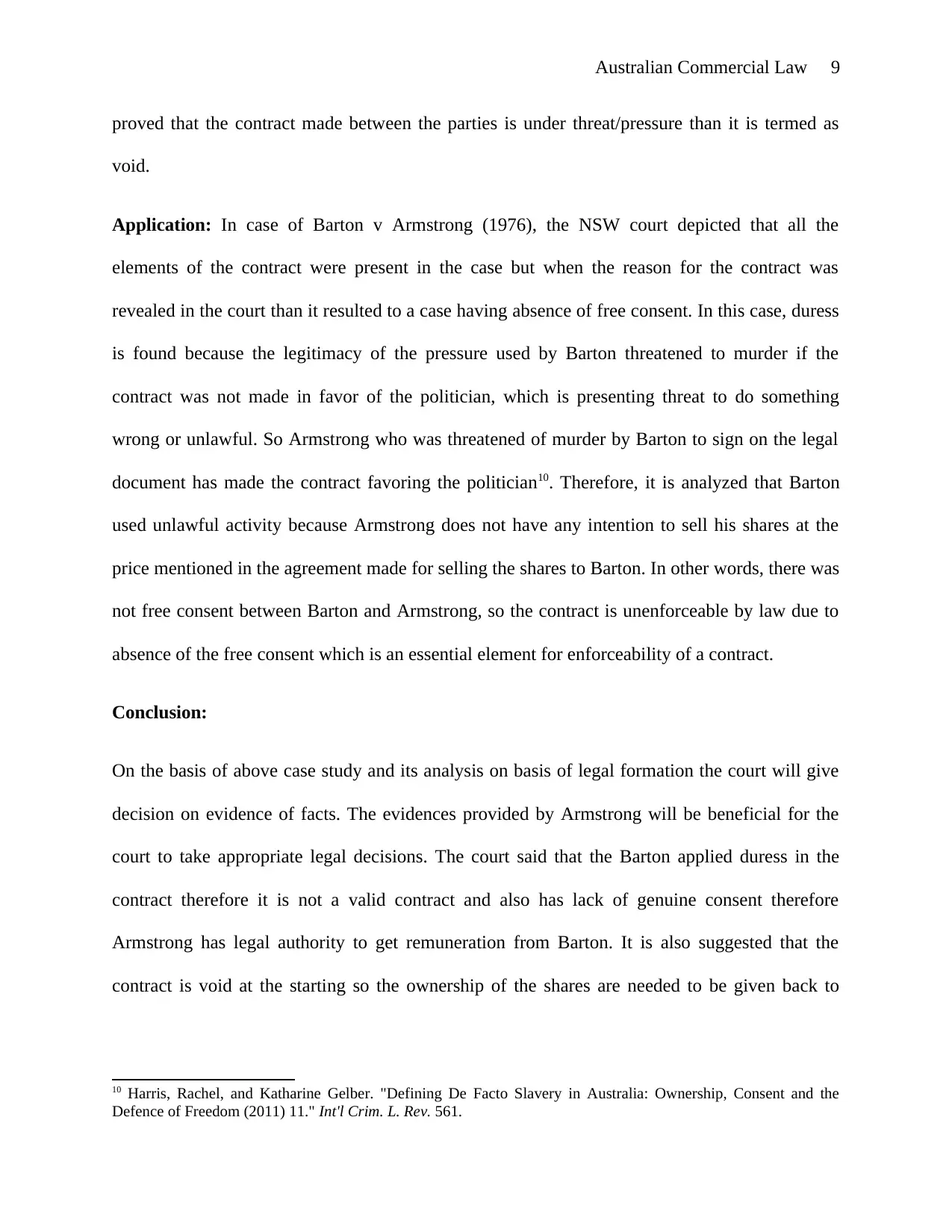
Australian Commercial Law 9
proved that the contract made between the parties is under threat/pressure than it is termed as
void.
Application: In case of Barton v Armstrong (1976), the NSW court depicted that all the
elements of the contract were present in the case but when the reason for the contract was
revealed in the court than it resulted to a case having absence of free consent. In this case, duress
is found because the legitimacy of the pressure used by Barton threatened to murder if the
contract was not made in favor of the politician, which is presenting threat to do something
wrong or unlawful. So Armstrong who was threatened of murder by Barton to sign on the legal
document has made the contract favoring the politician10. Therefore, it is analyzed that Barton
used unlawful activity because Armstrong does not have any intention to sell his shares at the
price mentioned in the agreement made for selling the shares to Barton. In other words, there was
not free consent between Barton and Armstrong, so the contract is unenforceable by law due to
absence of the free consent which is an essential element for enforceability of a contract.
Conclusion:
On the basis of above case study and its analysis on basis of legal formation the court will give
decision on evidence of facts. The evidences provided by Armstrong will be beneficial for the
court to take appropriate legal decisions. The court said that the Barton applied duress in the
contract therefore it is not a valid contract and also has lack of genuine consent therefore
Armstrong has legal authority to get remuneration from Barton. It is also suggested that the
contract is void at the starting so the ownership of the shares are needed to be given back to
10 Harris, Rachel, and Katharine Gelber. "Defining De Facto Slavery in Australia: Ownership, Consent and the
Defence of Freedom (2011) 11." Int'l Crim. L. Rev. 561.
proved that the contract made between the parties is under threat/pressure than it is termed as
void.
Application: In case of Barton v Armstrong (1976), the NSW court depicted that all the
elements of the contract were present in the case but when the reason for the contract was
revealed in the court than it resulted to a case having absence of free consent. In this case, duress
is found because the legitimacy of the pressure used by Barton threatened to murder if the
contract was not made in favor of the politician, which is presenting threat to do something
wrong or unlawful. So Armstrong who was threatened of murder by Barton to sign on the legal
document has made the contract favoring the politician10. Therefore, it is analyzed that Barton
used unlawful activity because Armstrong does not have any intention to sell his shares at the
price mentioned in the agreement made for selling the shares to Barton. In other words, there was
not free consent between Barton and Armstrong, so the contract is unenforceable by law due to
absence of the free consent which is an essential element for enforceability of a contract.
Conclusion:
On the basis of above case study and its analysis on basis of legal formation the court will give
decision on evidence of facts. The evidences provided by Armstrong will be beneficial for the
court to take appropriate legal decisions. The court said that the Barton applied duress in the
contract therefore it is not a valid contract and also has lack of genuine consent therefore
Armstrong has legal authority to get remuneration from Barton. It is also suggested that the
contract is void at the starting so the ownership of the shares are needed to be given back to
10 Harris, Rachel, and Katharine Gelber. "Defining De Facto Slavery in Australia: Ownership, Consent and the
Defence of Freedom (2011) 11." Int'l Crim. L. Rev. 561.
⊘ This is a preview!⊘
Do you want full access?
Subscribe today to unlock all pages.

Trusted by 1+ million students worldwide
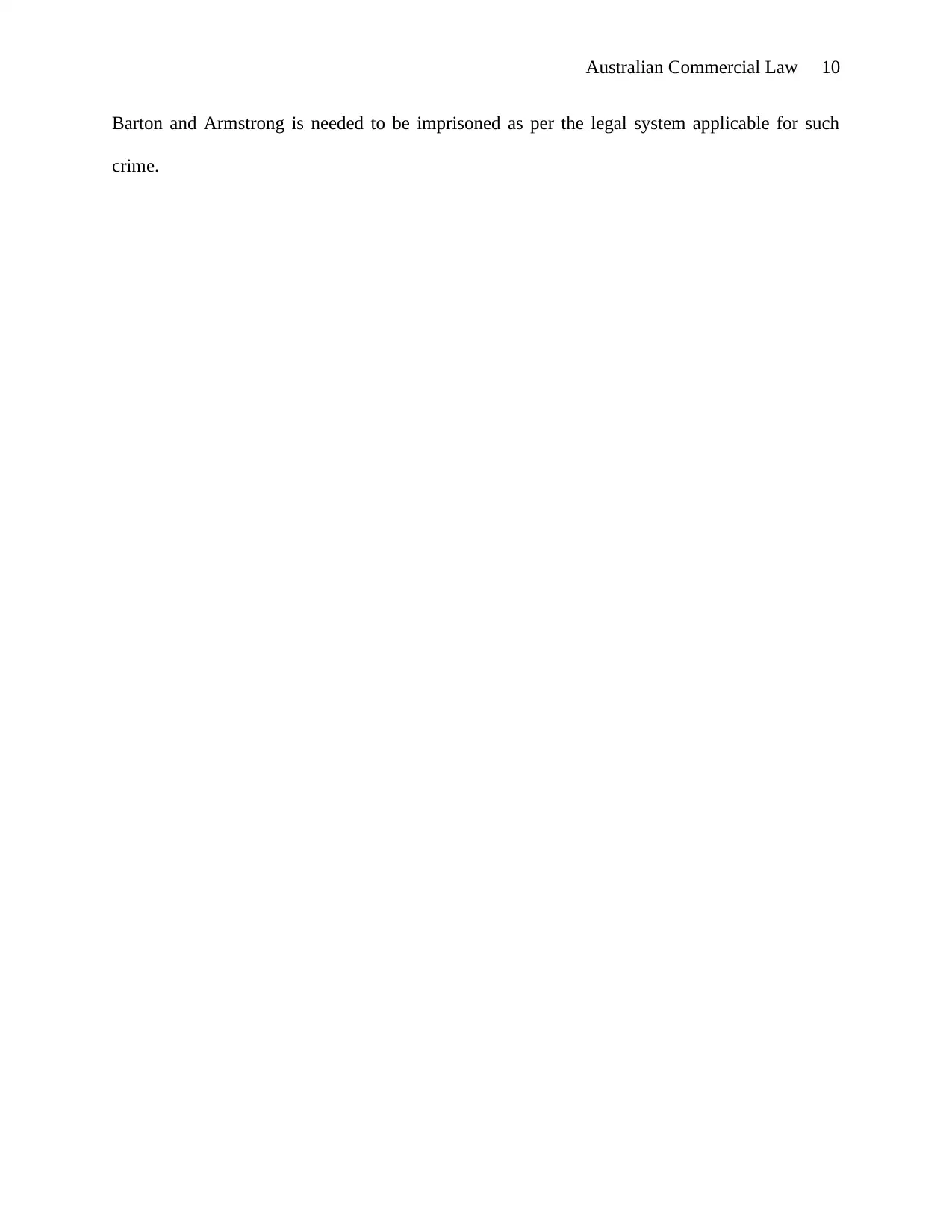
Australian Commercial Law 10
Barton and Armstrong is needed to be imprisoned as per the legal system applicable for such
crime.
Barton and Armstrong is needed to be imprisoned as per the legal system applicable for such
crime.
Paraphrase This Document
Need a fresh take? Get an instant paraphrase of this document with our AI Paraphraser
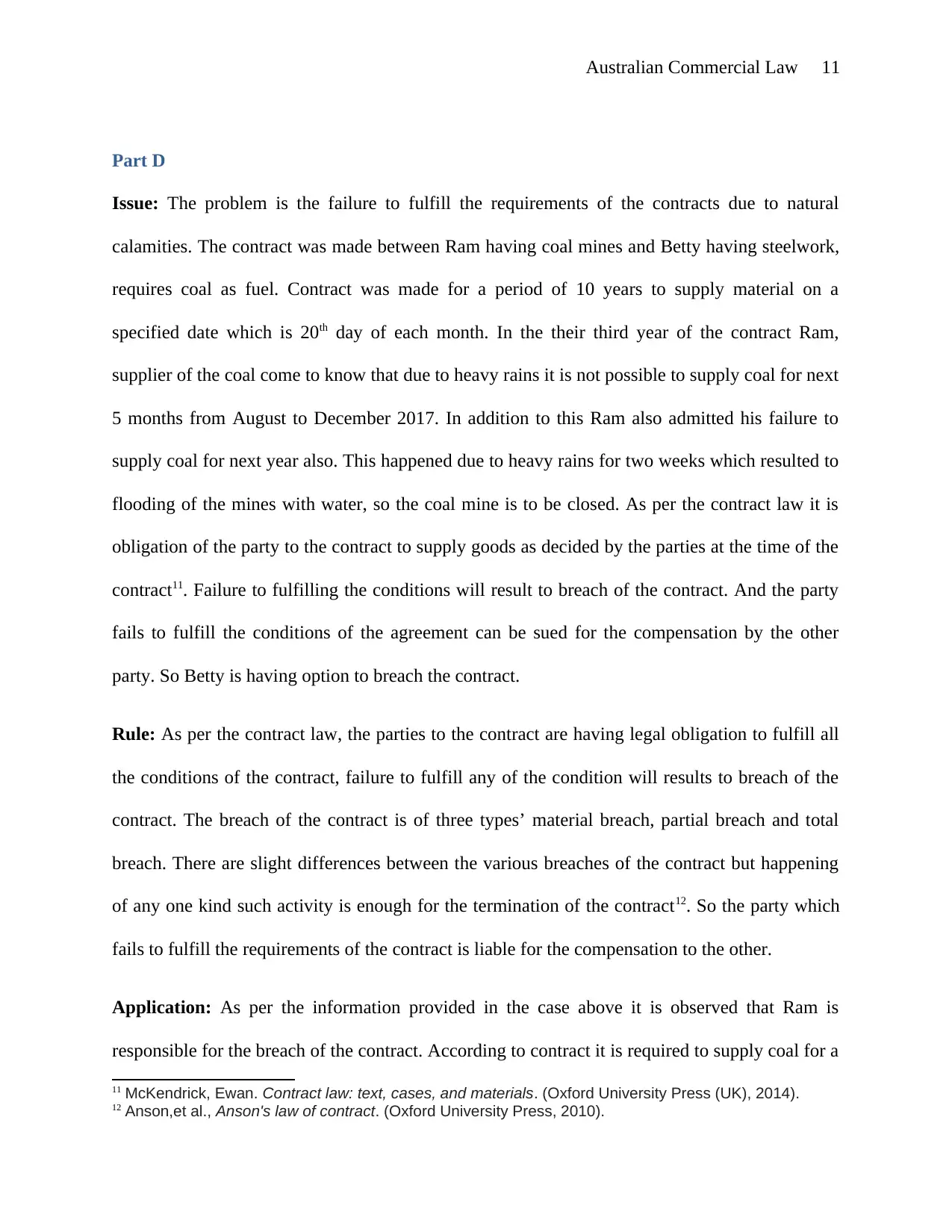
Australian Commercial Law 11
Part D
Issue: The problem is the failure to fulfill the requirements of the contracts due to natural
calamities. The contract was made between Ram having coal mines and Betty having steelwork,
requires coal as fuel. Contract was made for a period of 10 years to supply material on a
specified date which is 20th day of each month. In the their third year of the contract Ram,
supplier of the coal come to know that due to heavy rains it is not possible to supply coal for next
5 months from August to December 2017. In addition to this Ram also admitted his failure to
supply coal for next year also. This happened due to heavy rains for two weeks which resulted to
flooding of the mines with water, so the coal mine is to be closed. As per the contract law it is
obligation of the party to the contract to supply goods as decided by the parties at the time of the
contract11. Failure to fulfilling the conditions will result to breach of the contract. And the party
fails to fulfill the conditions of the agreement can be sued for the compensation by the other
party. So Betty is having option to breach the contract.
Rule: As per the contract law, the parties to the contract are having legal obligation to fulfill all
the conditions of the contract, failure to fulfill any of the condition will results to breach of the
contract. The breach of the contract is of three types’ material breach, partial breach and total
breach. There are slight differences between the various breaches of the contract but happening
of any one kind such activity is enough for the termination of the contract12. So the party which
fails to fulfill the requirements of the contract is liable for the compensation to the other.
Application: As per the information provided in the case above it is observed that Ram is
responsible for the breach of the contract. According to contract it is required to supply coal for a
11 McKendrick, Ewan. Contract law: text, cases, and materials. (Oxford University Press (UK), 2014).
12 Anson,et al., Anson's law of contract. (Oxford University Press, 2010).
Part D
Issue: The problem is the failure to fulfill the requirements of the contracts due to natural
calamities. The contract was made between Ram having coal mines and Betty having steelwork,
requires coal as fuel. Contract was made for a period of 10 years to supply material on a
specified date which is 20th day of each month. In the their third year of the contract Ram,
supplier of the coal come to know that due to heavy rains it is not possible to supply coal for next
5 months from August to December 2017. In addition to this Ram also admitted his failure to
supply coal for next year also. This happened due to heavy rains for two weeks which resulted to
flooding of the mines with water, so the coal mine is to be closed. As per the contract law it is
obligation of the party to the contract to supply goods as decided by the parties at the time of the
contract11. Failure to fulfilling the conditions will result to breach of the contract. And the party
fails to fulfill the conditions of the agreement can be sued for the compensation by the other
party. So Betty is having option to breach the contract.
Rule: As per the contract law, the parties to the contract are having legal obligation to fulfill all
the conditions of the contract, failure to fulfill any of the condition will results to breach of the
contract. The breach of the contract is of three types’ material breach, partial breach and total
breach. There are slight differences between the various breaches of the contract but happening
of any one kind such activity is enough for the termination of the contract12. So the party which
fails to fulfill the requirements of the contract is liable for the compensation to the other.
Application: As per the information provided in the case above it is observed that Ram is
responsible for the breach of the contract. According to contract it is required to supply coal for a
11 McKendrick, Ewan. Contract law: text, cases, and materials. (Oxford University Press (UK), 2014).
12 Anson,et al., Anson's law of contract. (Oxford University Press, 2010).
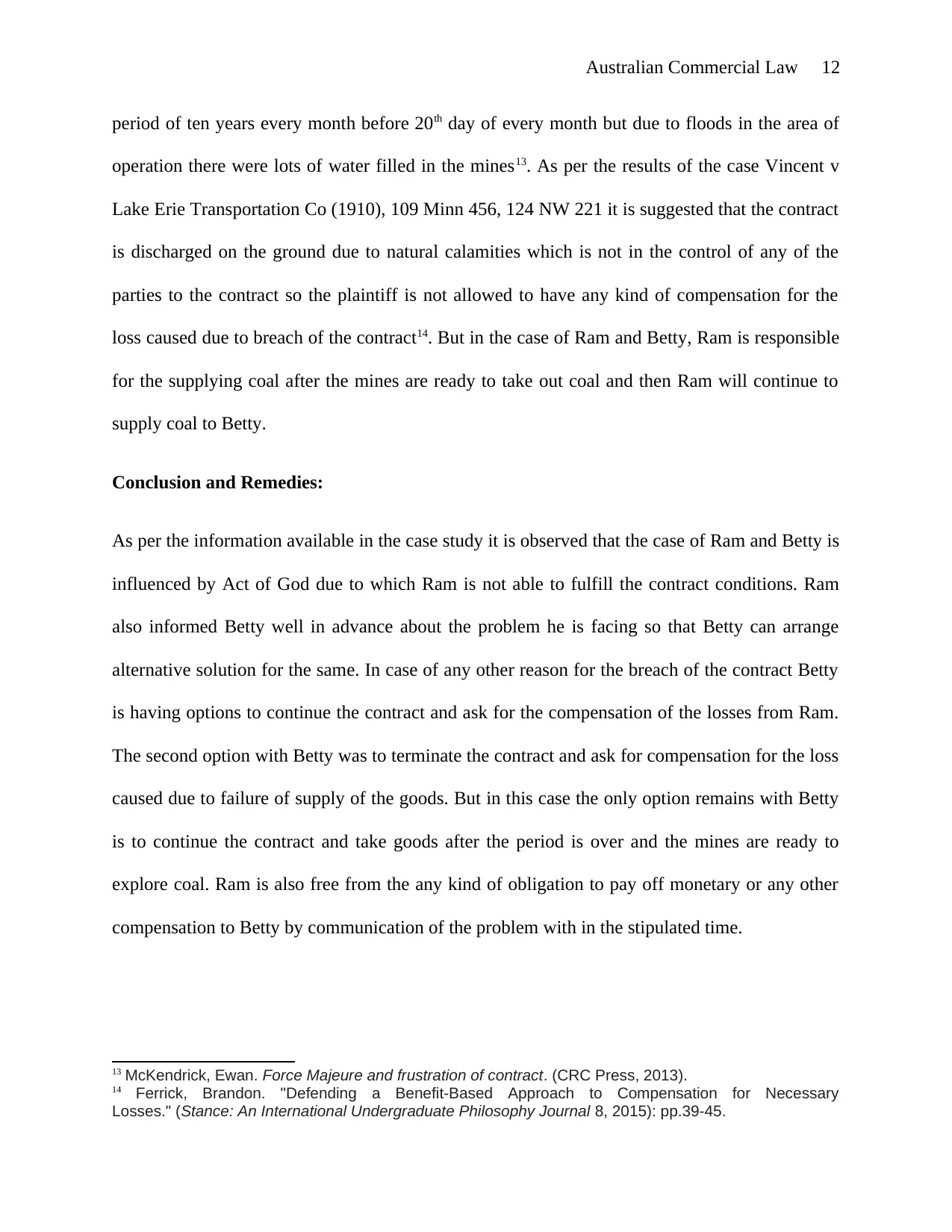
Australian Commercial Law 12
period of ten years every month before 20th day of every month but due to floods in the area of
operation there were lots of water filled in the mines13. As per the results of the case Vincent v
Lake Erie Transportation Co (1910), 109 Minn 456, 124 NW 221 it is suggested that the contract
is discharged on the ground due to natural calamities which is not in the control of any of the
parties to the contract so the plaintiff is not allowed to have any kind of compensation for the
loss caused due to breach of the contract14. But in the case of Ram and Betty, Ram is responsible
for the supplying coal after the mines are ready to take out coal and then Ram will continue to
supply coal to Betty.
Conclusion and Remedies:
As per the information available in the case study it is observed that the case of Ram and Betty is
influenced by Act of God due to which Ram is not able to fulfill the contract conditions. Ram
also informed Betty well in advance about the problem he is facing so that Betty can arrange
alternative solution for the same. In case of any other reason for the breach of the contract Betty
is having options to continue the contract and ask for the compensation of the losses from Ram.
The second option with Betty was to terminate the contract and ask for compensation for the loss
caused due to failure of supply of the goods. But in this case the only option remains with Betty
is to continue the contract and take goods after the period is over and the mines are ready to
explore coal. Ram is also free from the any kind of obligation to pay off monetary or any other
compensation to Betty by communication of the problem with in the stipulated time.
13 McKendrick, Ewan. Force Majeure and frustration of contract. (CRC Press, 2013).
14 Ferrick, Brandon. "Defending a Benefit-Based Approach to Compensation for Necessary
Losses." (Stance: An International Undergraduate Philosophy Journal 8, 2015): pp.39-45.
period of ten years every month before 20th day of every month but due to floods in the area of
operation there were lots of water filled in the mines13. As per the results of the case Vincent v
Lake Erie Transportation Co (1910), 109 Minn 456, 124 NW 221 it is suggested that the contract
is discharged on the ground due to natural calamities which is not in the control of any of the
parties to the contract so the plaintiff is not allowed to have any kind of compensation for the
loss caused due to breach of the contract14. But in the case of Ram and Betty, Ram is responsible
for the supplying coal after the mines are ready to take out coal and then Ram will continue to
supply coal to Betty.
Conclusion and Remedies:
As per the information available in the case study it is observed that the case of Ram and Betty is
influenced by Act of God due to which Ram is not able to fulfill the contract conditions. Ram
also informed Betty well in advance about the problem he is facing so that Betty can arrange
alternative solution for the same. In case of any other reason for the breach of the contract Betty
is having options to continue the contract and ask for the compensation of the losses from Ram.
The second option with Betty was to terminate the contract and ask for compensation for the loss
caused due to failure of supply of the goods. But in this case the only option remains with Betty
is to continue the contract and take goods after the period is over and the mines are ready to
explore coal. Ram is also free from the any kind of obligation to pay off monetary or any other
compensation to Betty by communication of the problem with in the stipulated time.
13 McKendrick, Ewan. Force Majeure and frustration of contract. (CRC Press, 2013).
14 Ferrick, Brandon. "Defending a Benefit-Based Approach to Compensation for Necessary
Losses." (Stance: An International Undergraduate Philosophy Journal 8, 2015): pp.39-45.
⊘ This is a preview!⊘
Do you want full access?
Subscribe today to unlock all pages.

Trusted by 1+ million students worldwide
1 out of 14
Related Documents
Your All-in-One AI-Powered Toolkit for Academic Success.
+13062052269
info@desklib.com
Available 24*7 on WhatsApp / Email
![[object Object]](/_next/static/media/star-bottom.7253800d.svg)
Unlock your academic potential
Copyright © 2020–2025 A2Z Services. All Rights Reserved. Developed and managed by ZUCOL.





